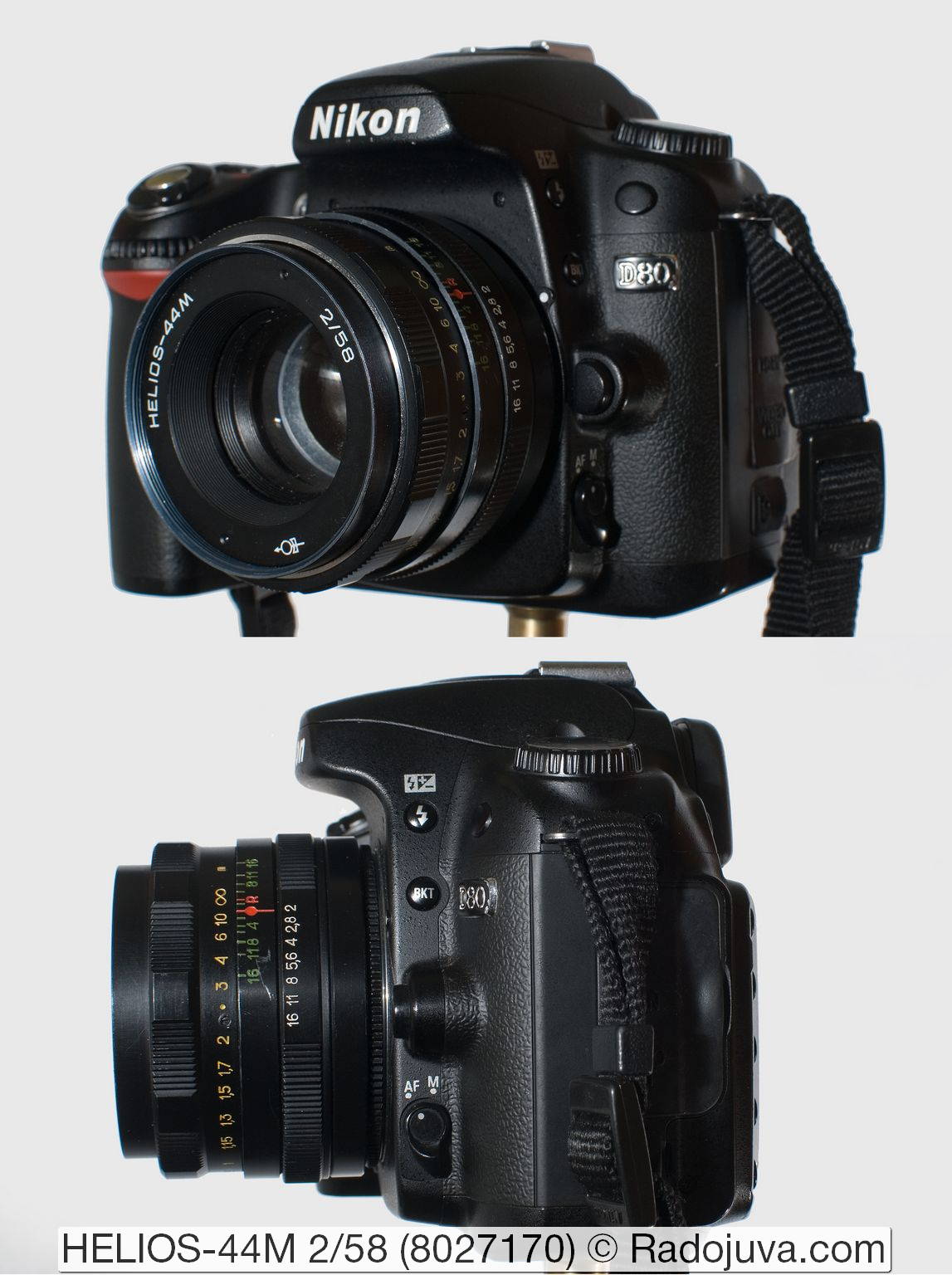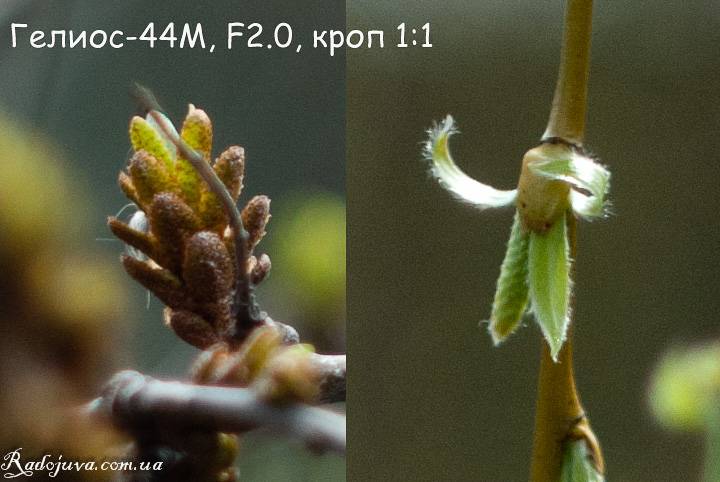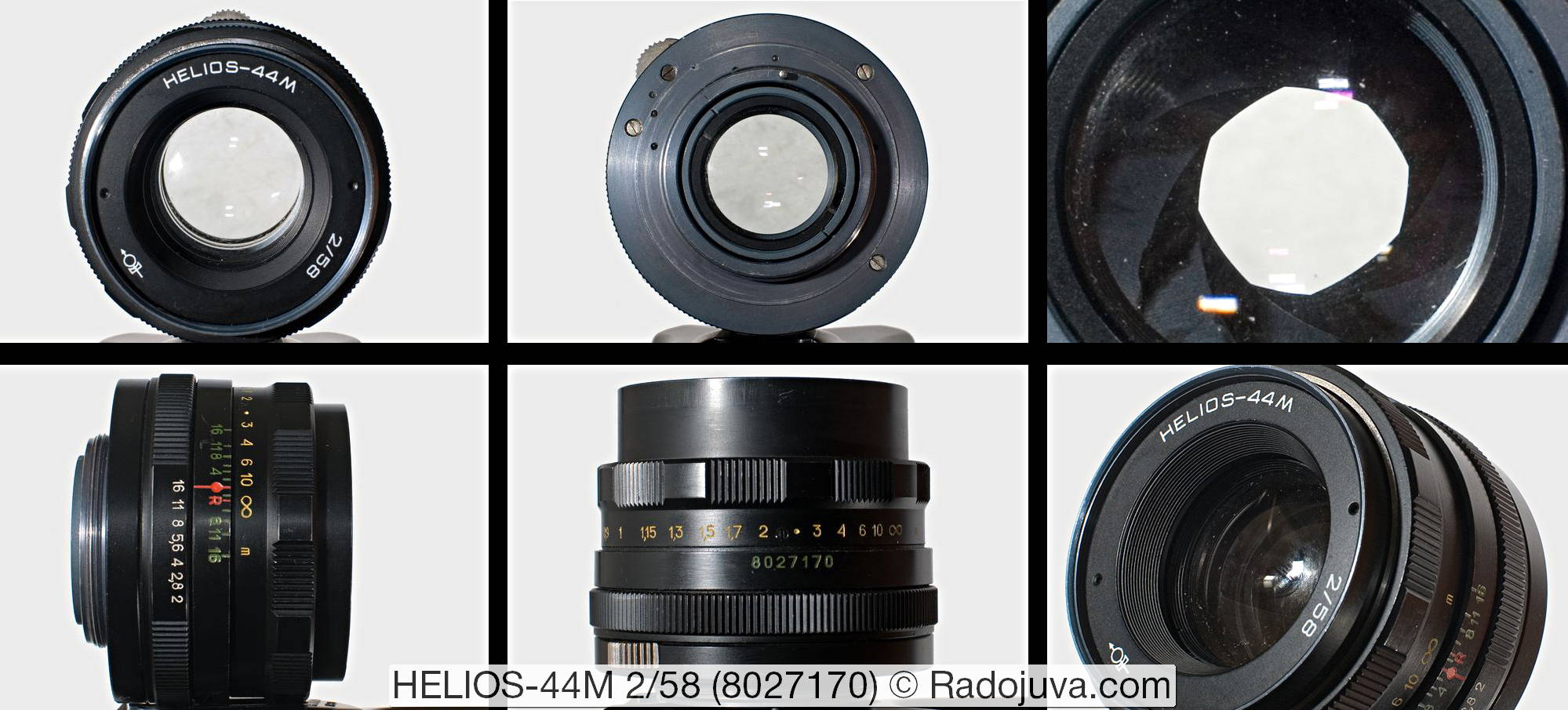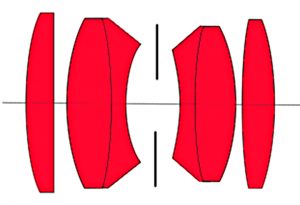According provided by lens HELIOS-44M 2/58 many thanks Ilya.
This review shows the 'HELIOS-44M 2/58' lens, serial number 8027170, manufactured at the Jupiter plant, Valdai. The lens is no different from the HELIOS-44M 2/58 manufactured at KMZ.
Main technical characteristics of HELIOS-44M 2/58:
| The name of the instance from the review (as it is written on the lens itself) | HELIOS-44M 2/58 8027170 with the logo of the Jupiter plant, Valdai |
| Basic properties |
|
| Front Filter Diameter | 52 mm |
| Focal length | 58 mm
|
| Zoom ratio | 1 x |
| Designed by | for film cameras with a frame size of 36 mm X 24 mm |
| Number of aperture blades | 8 rounded petals. The petals form an approximately regular hole. At an intermediate value between F / 2 and F / 4, the petals form a small jagged hole. Petals matt metal, not blackened. |
| Tags | focusing distance in meters only. DOF scale for F / 2.8, 4, 5.6, 8, 11, 16. Scale with aperture values for F / 2, 2.8, 4, 5.6, 8, 11, 16 (no intermediate values). 'R' mark for infrared operation. |
| Diaphragm | F / 2.0 to F / 16.0, adjustable with aperture ring, automatic 'A'or manual'M'aperture control mode. |
| MDF (minimum focusing distance) | 0.55 m, maximum magnification ratio is 1: 7.35 (approximately) |
| The weight | 270 g (approximately) |
| Optical design | 6 elements in 4 groups. Optical design type 'Planar' (Planar)
The optical scheme was copied from the Carl Zeiss Jena Biotat 2/58 lens and converted to Soviet optical glass. The same optical design is used by other modifications of Helios / Helios 44 2/58, as well as all modifications of Biotar 2/58. |
| Lens hood | screwed into the front filter, marking of the original hood not found. |
| Manufacturer country | USSR, plant 'Jupiter', Valdai |
| Period | The exact period is unknown. A copy of the review made in 1980. |
| Price | The cost of such a lens ranges from 10 to 25 cu
Prices for modern Helios lenses can be found at this link. |

HELIOS-44M 2/58, plant 'Jupiter', Valdai. The lens is shown on the camera Nikon D80. Installed using a KP-42 / N lensless adapter (aka M42-Nikon F)
Crop photos from the camera Nikon D200:

The sharpness of the Helios-44m lens. Clipping photos without processing.
Sample photos on HELIOS-44M 2/58:
All photos taken on Nikon D200, without processing, RAW -> JPEG auto levels Q80%, resized to 1600x1200, EXIF about shooting options.
How to use with modern cameras?
Lenses with mounting thread M42 (M42 X 1 / 45.5), such as the lens from this review, are very easy to use on almost any modern digital camera (both SLR and mirrorless), for this it is enough to choose the right adapter (adapter). You do not need to carry out any additional steps to modify the lens.
The cheapest adapters can be found at Aliexpress.com... There are adapters (adapters) with a chip that provide more convenience during shooting, usually chips are used to confirm focus and / or metering exposure, and form the correct EXIF. The chip does not affect the image quality in any way.
For some SLR cameras (for example, with the Nikon F-mount), you need to use adapters with a corrective lens, which allows you to focus correctly at all focusing distances. For any mirrorless cameras, such a lens is not needed, and the adapter is a simple decorated hollow metal tube with an appropriate mount.
For SLR cameras
- Canon: For cameras Canon EOS with bayonet mount EF / EF-S need an M42-Canon EOS adapter, such an adapter with a chip can be found herewithout chip here.
- NIKON: For cameras Nikon DX / FXas well as for cameras Fujifilm и Kodak with a Nikon F mount, you need an M42-Nikon F adapter, you can buy such an adapter without a lens and a chip here, with a lens without a chip herewith chip without lens here, with lens and chip here. Why a lens? Why chip?
- PENTAX: For Pentax cameras with K mount, you need an M42-Pentax K adapter, you can buy such an adapter here.
- SONY/MINOLTA: For cameras with a Sony / Minolta A mount, you need the M42-Sony A adapter, you can find such an adapter without a chip at this linkwith a chip at this link.
- OLYMPUS/PANASONIC/LEICA: For cameras with a 4/3 bayonet mount (not to be confused with Micro 4/3!) You need an M42-4 / 3 adapter, you can buy such an adapter here.
For mirrorless cameras
- SONY: For cameras with 'E'/'FE' mount series SonyNEX и Sony Alpha you need an adapter M42-Sony E (aka M42-Sony Nex), you can find it at this link. An autofocus adapter is also available for these cameras. Techart PRO Leica M - Sony E Autofocus Adapterwhich can be found at this link.
- OLYMPUS / PANASONIC / KODAK / XIAOMI: For cameras with a bayonet mount Micro 4/3 (Micro 4:3) you need an adapter M42-Micro 4/3, you can find it at this link.
- CANON M: For cameras with Canon EF-M mount need adapter M42-Canon M, it can be found at this link.
- CANON R and RF-S: For cameras with Canon RF mount need adapter M42-Canon R, it can be found at this link.
- Nikon 1: For cameras Nikon 1 Series need adapter M42-Nikon 1, you can find it at this link.
- Nikon Z: For cameras Nikon Z series (FX/DX) need an adapter M42-Nikon Z, it can be found at this link.
- FUJIFILM X: For cameras with mount X need an M42-Fuji X adapter, you can find it at this link.
- FUJIFILM GFX: For medium format cameras G-mount need M42-Fuji GFX adapter, you can find it at this link.
- SAMSUNG: For cameras with NX mount, you need an M42-Samsung NX adapter, you can find it at this link. There are no adapters for the NX mini camera yet.
- PENTAX: For Q-mount cameras, you need an M42-Pentax Q adapter, you can find it at this link.
- SIGMA / PANASONIC / LEICA: For cameras with L mount you need an M42-Leica L adapter, you can find it at this link.
- LEICA: For cameras with a bayonet mount Leica M need adapter M42-L / M, you can find it at this link.
If you have any questions on compatibility and adapters - ask in the comments (comments do not require any registration at all).
Reviews for the Helios-44 2/58 lenses:
- Helios-44 2/58 [KMZ, 13 petals, M39, silver, No. 0220423]
- Helios-44 2/58 [KMZ, 8 petals, M39, silver]
- Helios-44 1: 2 F = 5,8 cm П [KMZ with replaced lenses, No. 0007220, review of the lens from the reader Radozhiva]
- HELIOS-44M 2/58 [KMZ, 8 petals, serial number 7843528]
- HELIOS-44M 2/58 [Jupiter plant, Valdai, 8 petals, serial number 8027170]
- HELIOS-44-2 2/58 [plant 'Jupiter', Valdai, 8 petals, serial number 83052779] + autofocus review
- MS Helios 44-3 2/58 [MMZ, 8 petals, 8619437, 9167912]
- MC Helios-44M-4 2/58
- Helios-44K-4 58mm 1:2 [KMZ, 6 petals, Pentax K]
- MC Helios-44M-4 58mm 1: 2 [plant 'Jupiter', Valdai, 6 petals] + autofocus review
- MC Helios-44M-5 58mm 1: 2 [Jupiter plant, Valdai, 6 petals]
- MC Helios-44M-6 58mm 1: 2 [plant 'Jupiter', Valdai, 6 petals]
- MC Helios-44M-7 58mm 1: 2 [plant 'Jupiter', Valdai, 6 petals]
- An article about most of the major modifications of the Helios-44 series
- Gallery of pictures on MC Helios-44M-4
- Look at modern the lenses 'Helios' can at this link
- A lot of Helios of all varieties can be found on ebay this link
Original 'Carl Zeiss Jena Biotar 2/58 ':
- Carl Zeiss Jena Biotar 1: 2 f = 5,8cm T [17 diaphragm blades, M42]
- Carl Zeiss Jena Biotar 2 / 58 T [12 diaphragm blades, M42]
- A lot of Biotars of all varieties can be found on ebay this link
Look at modern the lenses 'Zenitar' и 'Helios' can at this link.
Comments on this post do not require registration. Anyone can leave a comment. Many different photographic equipment can be found on AliExpress.
Сonclusion
HELIOS-44M 2/58 - a good modification of the older versions of Helios-44 with good sharpness, unusual twisting of the background. The main difference from previous versions was blinking aperture with 'M / A' switch to select aperture control mode. There are two versions of what exactly the letter 'M' in the lens name stands for: Мorifice plate or Мlens identification.
Familiarity with the Soviet Helios brand lenses I recommend starting with an inexpensive and common lens Helios-44-2 2/58 (aka HELIOS-44-2 2/58). The following links can look at modern lenses Zenitar и HELIOS.
Material prepared Arkady Shapoval. Training/Consultations | Youtube | Facebook | Instagram | Twitter | Telegram














I saw the sale of the G-44m MS Krasnogorsk anywhere nowhere is there any information about this?
MS HELIOS-44M 2/58 h112 https://radojuva.com.ua/2015/04/gelios-44-helios/
thanks Arkady for the link, was 44-2valdai sold I want to try ms Krasnogorsk. As soon as the helios do not scold and you will not find such a photographer who would not shoot them. Indifferently, no one will leave anyone
For me, so very good optics that scolding them.
unstable quality, I personally like helios
Good afternoon. Tell me, if you compare Helios 44M and Helios 44-3 (MC). Which would be better? What is more convenient with a jumping diaphragm or manual? What to pay attention to? (except as a condition in general)
Manual is more convenient, as the jumping one was designed for the M42 mount with its diaphragm drive. With any adapter, the jump is blocked. Initially, manual control of the diaphragm is more convenient on modern CZKs, expose with one ring, close the petals with the second.
The MC version is always better than the non-MC version. Helios 44M is not the MC version.
thank you
I took out the Zenith em with Helios 44-3 (recall youth) I use Ken, but the zenith is in front! In general, we did very well, the device is 30 years old and takes off the class! And in his hand lies rooted to the spot! Like Kalashnikov!
m42-nikon adapter (or canon) can be bought here http://olx.ua/list/user/Bewr/
Tell me pzhl, on canon 6D will this glass cling to the mirror?
No, it will not.
The best lens in the world. I guarantee! After him, 81N wanted to smash the asphalt
Good afternoon, tell me which models fit Helios-44m
which company model?
I read a lot of good things about this famous 44th. It has been gathering dust with me since film times under the name HELIOS 44M.
And also lanthanum Industar 61 was littered. Both were in a wonderful state and at one time made a lot of wonderful pictures on the film.
And it must happen that I recently bought a digital SLR. Moreover, Nikon, in which “something is wrong” with the standardization of the flange focal lengths, as a result, Soviet lenses for the most part fly by like plywood or require significant improvements.
And the good old "tube" Nikon D40, still on an honest CCD, which gives such an amazing transmission that I will not exchange it for any modern one.
But to my great chagrin, I came across this incompatibility.
Having read all the tips and opinions on adapting the USSR to Nikon, I realized that this was not a task for me, I couldn’t handle it, and I had to abandon this undertaking.
Therefore, I have a very simple question: those who used this HELIOS 44M and Nikon AF-S Nikkor 50mm 1: 1.8G SWM Aspherical - which one gives the best results, and in what exactly?
If you say that 1.8G is better than the 44th, then at least it will console me :)
And I will buy it, and the 44th with its wonderful bokeh will continue to gather dust in the closet along with the I-61.
50g is good and better at least because the whole car. But I advise you to search the Internet again and find the right info about the alteration, put it on Nikon and enjoy the picture. My first I-61ls manual was redone by myself and only after the passage of time (and other lenses through my handles) I realized that the Indian was the most difficult. And if you’re completely unsure of yourself, sell and take autofocus.
> But I advise you to search the Internet again and find the correct information about the alteration, put it on Nikon and enjoy the picture.
To do this, there must first be a goal. And for it to appear, I first need to get an answer to my simple question.
Can you tell me something about it?
look at examples of voto on the Internet and compare, because everyone has their own beauty.
Optically, of course, Nikonovsky is better, but you can also have 2 lenses for artistic purposes.
These lenses cannot be compared; they are very different. Helios is filmed mainly for the specific bokeh. But shooting with a manual lens is not easy, especially with an old camera without live view and focusing. I also have Nikon, d3000 and recently it has settled 44m-6. If you want to try Helios on a number, I advise you to look for just such a lens (a modification with an index of 7, and probably from 4 and 5, is also suitable, because practically anyone can remake it, the main thing is that the hands grow more or less from the right place)). http://slava-zitev.livejournal.com/68733.html - I reworked my own with the help of this article, + made my own amendments.
Since you bought a used Nikon, maybe you should change it to a Canon one and not take a steam bath with the alteration? What-thread old 300d gives not a bad picture
Dear Arkady, you have some kind of confusion in the name of the Helios.
On page https://radojuva.com/photo-review/#helios under paragraph 5
it is called “Helios-44M 58mm F2.0 (two lenses: Valdai and KMZ)”,
but when you click on this link, you get to the page https://radojuva.com/2012/04/obzor-gelios-44m-58mm-f2-0/
where it is already called "Helios-44m".
You can’t shuffle English and Russian names so freely, in serious technical literature this is not accepted.
Once the manufacturer named it in English, then it must be adhered to, otherwise these liberties can sometimes lead to incidents and confusion.
In this case, Helios, perhaps, was exported, and had some differences from its Russified counterpart, or maybe not, it is better for photo historians to say this.
A big request to abide by this simple rule!
My love for Soviet optics began with him) Examples of photos here-
https://cloud.mail.ru/home/Helios%2044%20m/
and where is the review? I have almost one, the manufacturer is different.
it’s impossible to shoot normally on it, only the Bosko fit in ((((if at least I take off my waist, I can’t visit for sharpness
Good afternoon. Tell me, do all helios spin the bokeh, and what is the reason for the twisted bokeh?
With uncorrected geometric vignetting. This is such an uncorrected defect, they sacrificed it so that the remaining aberrations would not be so strong.
Redesigned his father's HELIOS 44M under the NIKON D7000. I bought an adapter for it and with the help of one useful article I achieved infinity for this lens without any additional lenses and without loss of image quality, the result was very pleasing to me.
Arkady, I will be very kind if you tell me, is it Valdai with multi-layer enlightenment?
In one comment, they regretted the sensitivity to backlighting. I accidentally tried to fasten the hood from JUPITER-37A. Everything has come up!
Thanks for the review, but I think the letters on the M / A switch of the aperture mode still mean: "A" - automatic (that is, "jumping" aperture) and "M" - manual (that is, manual setting)
Canon EOS 80D, Helios 44M 2/58 Lens
Which adapter is better to take: without a chip, with a chip, with a lens, with a lens and a chip?
Who will say that?
With a chip without a lens. On Kenon, she is not needed.
OK! Thanks! I thought so.
mine is very sharp on f11. with reynox 250 super for macro
Good afternoon, Arkady.
Tell me, please, on my d90 the focal length of Helios 58 can be considered as 87 because of the crop? To take a portrait on the chest, you have to retreat by 1,5 m, and maybe more.
Recalculation of the focal length taking into account the crop factor is more important for photographers who take both a full frame and a crop to take into account the change in the angle of view when shooting on the same focal point on different cameras. For those who take pictures all the time (or all the time for a full frame), these recalculations in principle have no meaning.
This is approximately the same as recalculating the distance of one jump on the Earth and on the Moon, taking into account different attractive forces. If you are on Earth all the time, then what difference does it make to you, what kind of recalculation is there, you just need to understand what effort you need to make in order to overcome different distances on Earth. But if you wander from the Earth to the Moon, of course, it is important to take into account the difference obtained by the same effort here and there.
Yes, it should be so. On any cropped camera, the EGF of the lens must always be counted with any lens.
Good afternoon.
Tell me, please, how to enter information about the manual lens and its aperture at the time of shooting in EXIF?
Good time of day. I got my Soviet Zenith EM with HELIOS-44M 2/58. Please tell me how to adapt it to Nikon D5500? Adapter, etc. Thanks.
The review is written.
It is not clear which adapter to choose for Nikon D5500 for HELIOS-44M 2/58? - an adapter without a lens and a chip, with a lens without a chip, with a chip without a lens, with a lens and a chip ?? ... (Well, not good at this, help with advice ...)
And this is up to you. Each of the methods has its own disadvantages and advantages. About the lens here (it degrades quality, but allows focusing further than 2 meters). Pro chip here (It allows you to use exposure metering, and, as a result, all camera modes, provides some other advantages, such as pseudo focus). How to work with manual lenses, including the D5500, is described here (how to twist rings and where to look).
Unfortunately, there is no very short and simple answer to your question.
I recommend selling 44m and taking Helios-81n due to the preservation of infinity without a lens. If at the moment there are such questions, it is even better to take autofocus Yongnuo 50 / 1.8, there can be much more sense with him.
adapter without lens and chip - you will be able to focus up to 1,5 meters from the camera and that's it, on the D5500 you can work only with manual setting of the exposure pair (in the M mode of the camera), in other modes the camera will not see the lens, i.e. you can't take a shot. With a lens without a chip - you can focus at all focusing distances to infinity, but the image quality will become worse due to the lens, work only in mode M. With a chip without a lens, you can work in aperture priority mode, but focus up to 1,5 meters from camera and that's it, with a lens and a chip - you can focus at all focusing distances to infinity, but the image quality will become worse due to the lens, work in M (manual) and A (aperture priority) modes. Any variant of using M42 optics on Nikon, without "sawing", will be clumsy. And without a chip, and with a chip, the D5500 also has incomplete functionality. While I was writing, I saw Arkady's comments, listen to him - buy a Chinese fifty, there will be more sense)
Good afternoon, I want to “screw” this lens to Samsung NX1000. I understand correctly that there are no adapters with a chip for this case, i.e. there will be no confirmation of focus?
Hello. I found my old Zenith with Gelik from my father (I thought I threw it away), the state is perfect, as I used it (at one time) carefully. The lens has a tight focusing ring, I don't even remember whether it was (should be) or not. If not, is it difficult to disassemble and lubricate it, hands grow from where you need it ...
Not so hard, there is a video on disassembling this lens on the internet